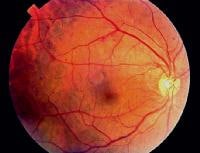Diabetic retinopathy is the leading cause of new blindness in persons aged 25-74 years in the United States. Approximately 700,000 persons in the United States have proliferative diabetic retinopathy, with an annual incidence of 65,000. A recent estimate of the prevalence of diabetic retinopathy in the United States showed a high prevalence of 28.5% among those with diabetes aged 40 years and older

Patients with diabetes often develop ophthalmic complications, such as corneal abnormalities, glaucoma, iris neovascularization, cataracts, and neuropathies. The most common and potentially most blinding of these complications, however, is diabetic retinopathy
In the initial stages of diabetic retinopathy, patients are generally asymptomatic, but in more advanced stages of the disease patients may experience symptoms that include floaters, distortion, and/or and blurred vision. Microaneurysms are the earliest clinical sign of diabetic retinopathy
The exact mechanism by which diabetes causes retinopathy remains unclear
Of the approximately 16 million Americans with diabetes, 50% are unaware that they have it. Of those who know they have diabetes, only half receive appropriate eye care. Thus, it is not surprising that diabetic retinopathy is the leading cause of new blindness in persons aged 25-74 years in the United States.
Diabetes is responsible for approximately 8000 eyes becoming blinded each year, meaning that diabetes is responsible for 12% of blindness. The rate is even higher among certain ethnic groups. An increased risk of diabetic retinopathy appears to exist in patients of Native American, Hispanic, and African American heritage
==================
JOIN OUR PAGE IN FACEBOOK


Patients with diabetes often develop ophthalmic complications, such as corneal abnormalities, glaucoma, iris neovascularization, cataracts, and neuropathies. The most common and potentially most blinding of these complications, however, is diabetic retinopathy
In the initial stages of diabetic retinopathy, patients are generally asymptomatic, but in more advanced stages of the disease patients may experience symptoms that include floaters, distortion, and/or and blurred vision. Microaneurysms are the earliest clinical sign of diabetic retinopathy
The exact mechanism by which diabetes causes retinopathy remains unclear
Of the approximately 16 million Americans with diabetes, 50% are unaware that they have it. Of those who know they have diabetes, only half receive appropriate eye care. Thus, it is not surprising that diabetic retinopathy is the leading cause of new blindness in persons aged 25-74 years in the United States.
Understanding Proliferative Diabetic Retinopathy
Diabetic Retinopathy
Diabetes is responsible for approximately 8000 eyes becoming blinded each year, meaning that diabetes is responsible for 12% of blindness. The rate is even higher among certain ethnic groups. An increased risk of diabetic retinopathy appears to exist in patients of Native American, Hispanic, and African American heritage
==================
JOIN OUR PAGE IN FACEBOOK



 1:17 PM
1:17 PM
 Unknown
Unknown

 Posted in:
Posted in:
1 comments:
Diabetic Retinopathy:
The most important complication for Diabetic patient,so most diabetic patient must examine eyes every 6-12 months to early management
follow us
Ask Qestions?
Post a Comment